An Analysis of State and Church Efforts in Combating Human Trafficking
VerifiedAdded on 2021/06/14
|5
|1031
|30
Essay
AI Summary
This essay delves into the critical issue of slavery and human trafficking, examining the distinct yet interconnected roles of the state and the Church in addressing this global challenge. The essay highlights the historical context and evolving perspectives of both entities, emphasizing their shared goal of achieving the common good, despite their differing approaches. It explores the significance of Pope Francis's humanitarian efforts and the collaborative, albeit sometimes confrontational, relationship between the United Nations and the Catholic Church. Furthermore, the essay analyzes how the state and the Church complement each other, particularly in the context of law enforcement, victim support, and advocacy. The essay concludes by underscoring the unique contributions of both the state and the Church in combating human trafficking, emphasizing the need for continued cooperation and a comprehensive approach to eradicate modern slavery.
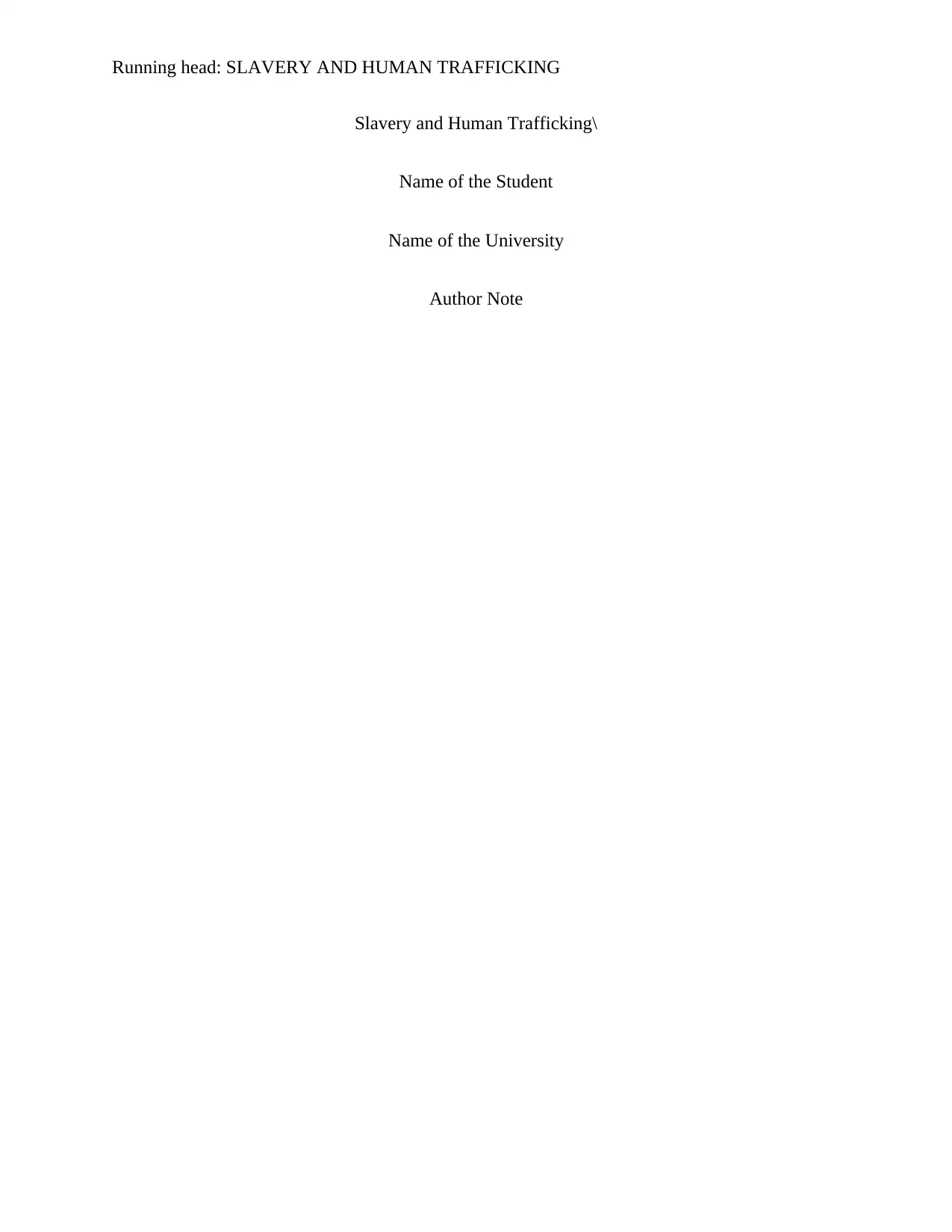
Running head: SLAVERY AND HUMAN TRAFFICKING
Slavery and Human Trafficking\
Name of the Student
Name of the University
Author Note
Slavery and Human Trafficking\
Name of the Student
Name of the University
Author Note
Paraphrase This Document
Need a fresh take? Get an instant paraphrase of this document with our AI Paraphraser
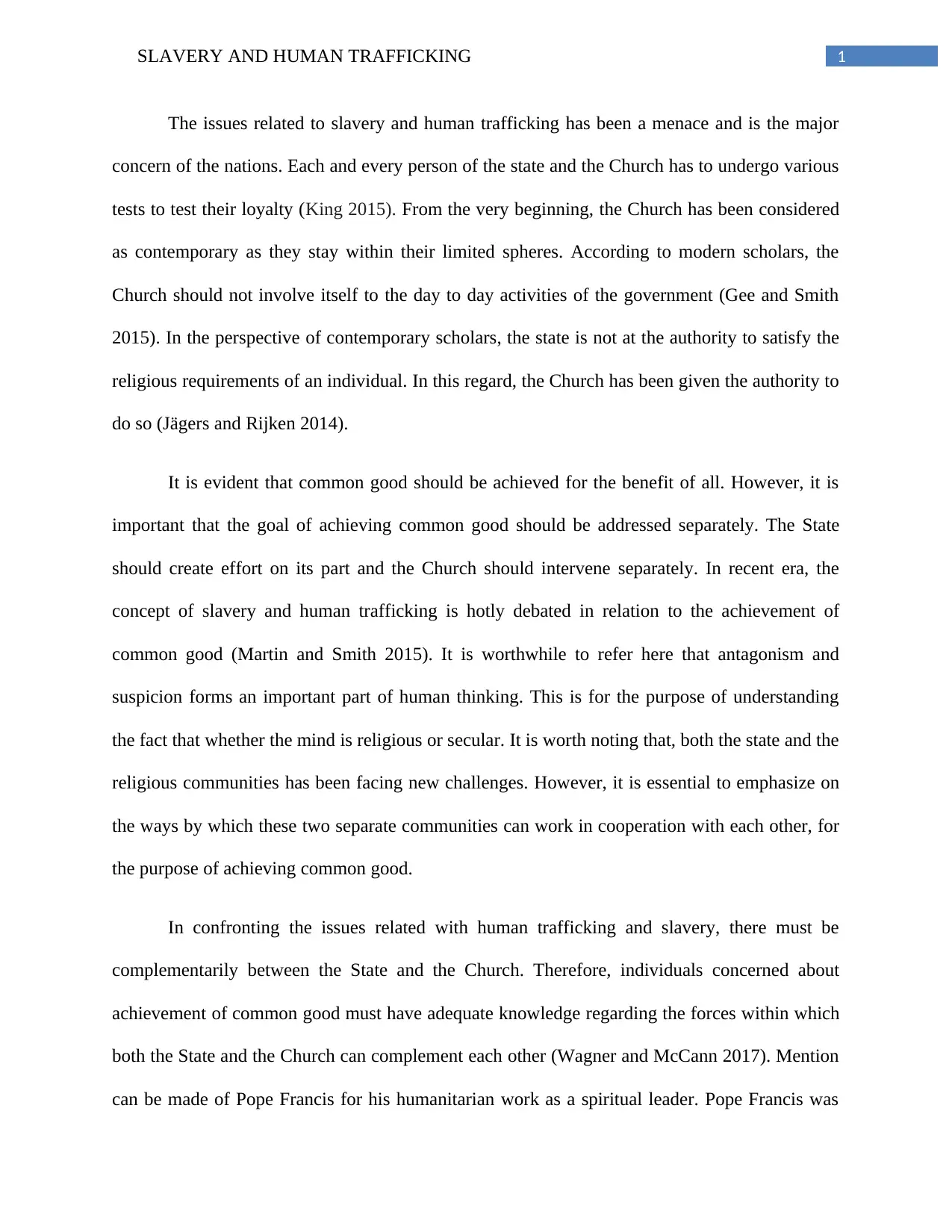
1SLAVERY AND HUMAN TRAFFICKING
The issues related to slavery and human trafficking has been a menace and is the major
concern of the nations. Each and every person of the state and the Church has to undergo various
tests to test their loyalty (King 2015). From the very beginning, the Church has been considered
as contemporary as they stay within their limited spheres. According to modern scholars, the
Church should not involve itself to the day to day activities of the government (Gee and Smith
2015). In the perspective of contemporary scholars, the state is not at the authority to satisfy the
religious requirements of an individual. In this regard, the Church has been given the authority to
do so (Jägers and Rijken 2014).
It is evident that common good should be achieved for the benefit of all. However, it is
important that the goal of achieving common good should be addressed separately. The State
should create effort on its part and the Church should intervene separately. In recent era, the
concept of slavery and human trafficking is hotly debated in relation to the achievement of
common good (Martin and Smith 2015). It is worthwhile to refer here that antagonism and
suspicion forms an important part of human thinking. This is for the purpose of understanding
the fact that whether the mind is religious or secular. It is worth noting that, both the state and the
religious communities has been facing new challenges. However, it is essential to emphasize on
the ways by which these two separate communities can work in cooperation with each other, for
the purpose of achieving common good.
In confronting the issues related with human trafficking and slavery, there must be
complementarily between the State and the Church. Therefore, individuals concerned about
achievement of common good must have adequate knowledge regarding the forces within which
both the State and the Church can complement each other (Wagner and McCann 2017). Mention
can be made of Pope Francis for his humanitarian work as a spiritual leader. Pope Francis was
The issues related to slavery and human trafficking has been a menace and is the major
concern of the nations. Each and every person of the state and the Church has to undergo various
tests to test their loyalty (King 2015). From the very beginning, the Church has been considered
as contemporary as they stay within their limited spheres. According to modern scholars, the
Church should not involve itself to the day to day activities of the government (Gee and Smith
2015). In the perspective of contemporary scholars, the state is not at the authority to satisfy the
religious requirements of an individual. In this regard, the Church has been given the authority to
do so (Jägers and Rijken 2014).
It is evident that common good should be achieved for the benefit of all. However, it is
important that the goal of achieving common good should be addressed separately. The State
should create effort on its part and the Church should intervene separately. In recent era, the
concept of slavery and human trafficking is hotly debated in relation to the achievement of
common good (Martin and Smith 2015). It is worthwhile to refer here that antagonism and
suspicion forms an important part of human thinking. This is for the purpose of understanding
the fact that whether the mind is religious or secular. It is worth noting that, both the state and the
religious communities has been facing new challenges. However, it is essential to emphasize on
the ways by which these two separate communities can work in cooperation with each other, for
the purpose of achieving common good.
In confronting the issues related with human trafficking and slavery, there must be
complementarily between the State and the Church. Therefore, individuals concerned about
achievement of common good must have adequate knowledge regarding the forces within which
both the State and the Church can complement each other (Wagner and McCann 2017). Mention
can be made of Pope Francis for his humanitarian work as a spiritual leader. Pope Francis was
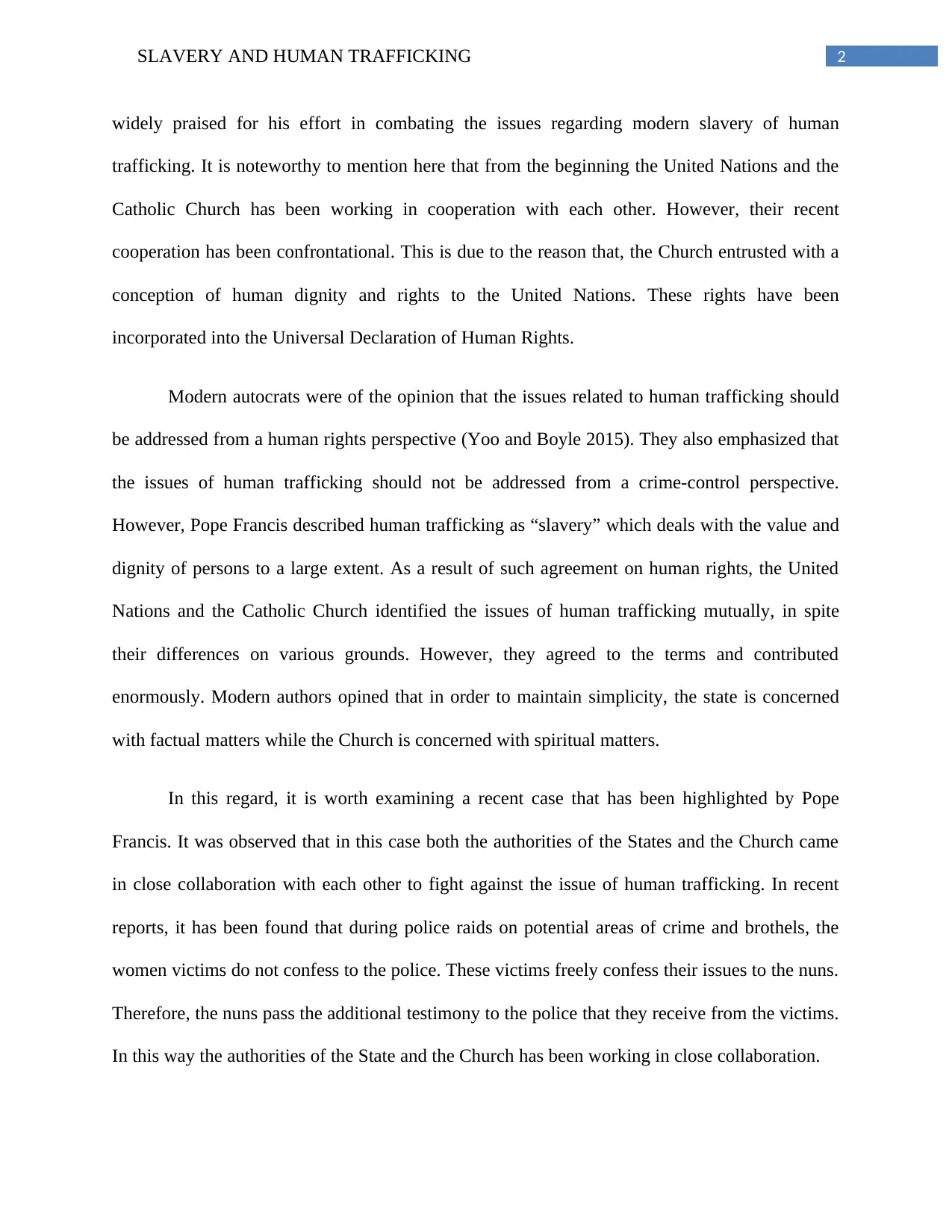
2SLAVERY AND HUMAN TRAFFICKING
widely praised for his effort in combating the issues regarding modern slavery of human
trafficking. It is noteworthy to mention here that from the beginning the United Nations and the
Catholic Church has been working in cooperation with each other. However, their recent
cooperation has been confrontational. This is due to the reason that, the Church entrusted with a
conception of human dignity and rights to the United Nations. These rights have been
incorporated into the Universal Declaration of Human Rights.
Modern autocrats were of the opinion that the issues related to human trafficking should
be addressed from a human rights perspective (Yoo and Boyle 2015). They also emphasized that
the issues of human trafficking should not be addressed from a crime-control perspective.
However, Pope Francis described human trafficking as “slavery” which deals with the value and
dignity of persons to a large extent. As a result of such agreement on human rights, the United
Nations and the Catholic Church identified the issues of human trafficking mutually, in spite
their differences on various grounds. However, they agreed to the terms and contributed
enormously. Modern authors opined that in order to maintain simplicity, the state is concerned
with factual matters while the Church is concerned with spiritual matters.
In this regard, it is worth examining a recent case that has been highlighted by Pope
Francis. It was observed that in this case both the authorities of the States and the Church came
in close collaboration with each other to fight against the issue of human trafficking. In recent
reports, it has been found that during police raids on potential areas of crime and brothels, the
women victims do not confess to the police. These victims freely confess their issues to the nuns.
Therefore, the nuns pass the additional testimony to the police that they receive from the victims.
In this way the authorities of the State and the Church has been working in close collaboration.
widely praised for his effort in combating the issues regarding modern slavery of human
trafficking. It is noteworthy to mention here that from the beginning the United Nations and the
Catholic Church has been working in cooperation with each other. However, their recent
cooperation has been confrontational. This is due to the reason that, the Church entrusted with a
conception of human dignity and rights to the United Nations. These rights have been
incorporated into the Universal Declaration of Human Rights.
Modern autocrats were of the opinion that the issues related to human trafficking should
be addressed from a human rights perspective (Yoo and Boyle 2015). They also emphasized that
the issues of human trafficking should not be addressed from a crime-control perspective.
However, Pope Francis described human trafficking as “slavery” which deals with the value and
dignity of persons to a large extent. As a result of such agreement on human rights, the United
Nations and the Catholic Church identified the issues of human trafficking mutually, in spite
their differences on various grounds. However, they agreed to the terms and contributed
enormously. Modern authors opined that in order to maintain simplicity, the state is concerned
with factual matters while the Church is concerned with spiritual matters.
In this regard, it is worth examining a recent case that has been highlighted by Pope
Francis. It was observed that in this case both the authorities of the States and the Church came
in close collaboration with each other to fight against the issue of human trafficking. In recent
reports, it has been found that during police raids on potential areas of crime and brothels, the
women victims do not confess to the police. These victims freely confess their issues to the nuns.
Therefore, the nuns pass the additional testimony to the police that they receive from the victims.
In this way the authorities of the State and the Church has been working in close collaboration.
⊘ This is a preview!⊘
Do you want full access?
Subscribe today to unlock all pages.

Trusted by 1+ million students worldwide
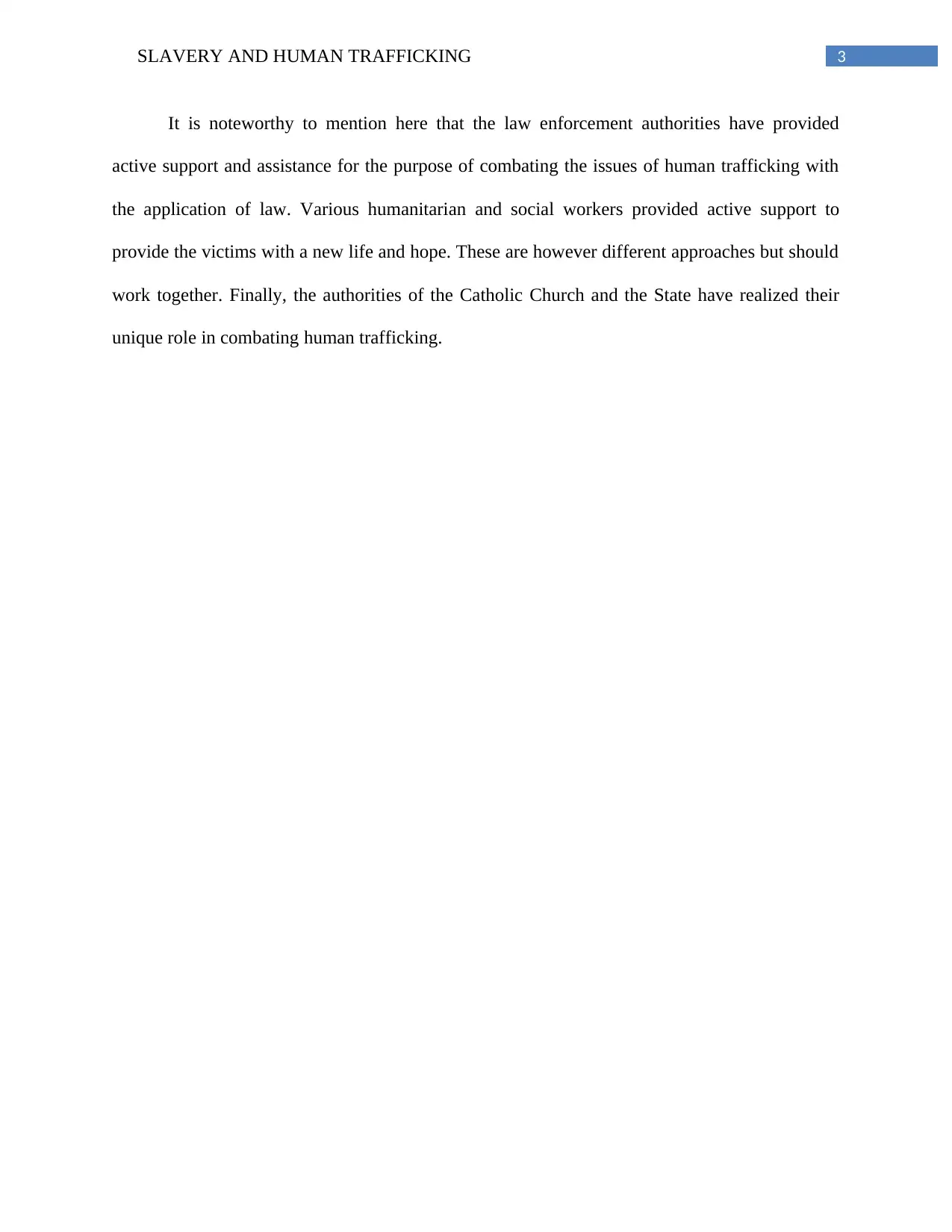
3SLAVERY AND HUMAN TRAFFICKING
It is noteworthy to mention here that the law enforcement authorities have provided
active support and assistance for the purpose of combating the issues of human trafficking with
the application of law. Various humanitarian and social workers provided active support to
provide the victims with a new life and hope. These are however different approaches but should
work together. Finally, the authorities of the Catholic Church and the State have realized their
unique role in combating human trafficking.
It is noteworthy to mention here that the law enforcement authorities have provided
active support and assistance for the purpose of combating the issues of human trafficking with
the application of law. Various humanitarian and social workers provided active support to
provide the victims with a new life and hope. These are however different approaches but should
work together. Finally, the authorities of the Catholic Church and the State have realized their
unique role in combating human trafficking.
Paraphrase This Document
Need a fresh take? Get an instant paraphrase of this document with our AI Paraphraser
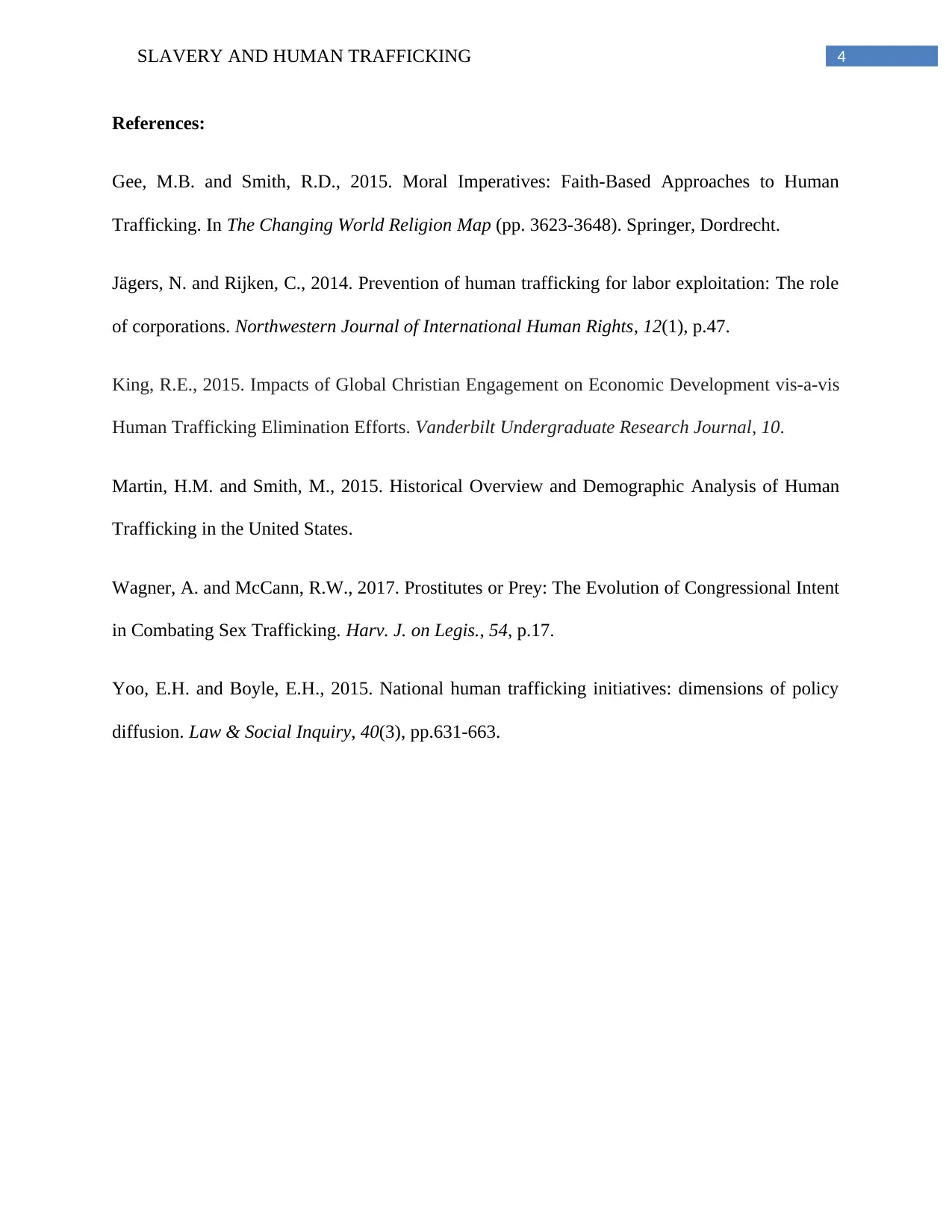
4SLAVERY AND HUMAN TRAFFICKING
References:
Gee, M.B. and Smith, R.D., 2015. Moral Imperatives: Faith-Based Approaches to Human
Trafficking. In The Changing World Religion Map (pp. 3623-3648). Springer, Dordrecht.
Jägers, N. and Rijken, C., 2014. Prevention of human trafficking for labor exploitation: The role
of corporations. Northwestern Journal of International Human Rights, 12(1), p.47.
King, R.E., 2015. Impacts of Global Christian Engagement on Economic Development vis-a-vis
Human Trafficking Elimination Efforts. Vanderbilt Undergraduate Research Journal, 10.
Martin, H.M. and Smith, M., 2015. Historical Overview and Demographic Analysis of Human
Trafficking in the United States.
Wagner, A. and McCann, R.W., 2017. Prostitutes or Prey: The Evolution of Congressional Intent
in Combating Sex Trafficking. Harv. J. on Legis., 54, p.17.
Yoo, E.H. and Boyle, E.H., 2015. National human trafficking initiatives: dimensions of policy
diffusion. Law & Social Inquiry, 40(3), pp.631-663.
References:
Gee, M.B. and Smith, R.D., 2015. Moral Imperatives: Faith-Based Approaches to Human
Trafficking. In The Changing World Religion Map (pp. 3623-3648). Springer, Dordrecht.
Jägers, N. and Rijken, C., 2014. Prevention of human trafficking for labor exploitation: The role
of corporations. Northwestern Journal of International Human Rights, 12(1), p.47.
King, R.E., 2015. Impacts of Global Christian Engagement on Economic Development vis-a-vis
Human Trafficking Elimination Efforts. Vanderbilt Undergraduate Research Journal, 10.
Martin, H.M. and Smith, M., 2015. Historical Overview and Demographic Analysis of Human
Trafficking in the United States.
Wagner, A. and McCann, R.W., 2017. Prostitutes or Prey: The Evolution of Congressional Intent
in Combating Sex Trafficking. Harv. J. on Legis., 54, p.17.
Yoo, E.H. and Boyle, E.H., 2015. National human trafficking initiatives: dimensions of policy
diffusion. Law & Social Inquiry, 40(3), pp.631-663.
1 out of 5
Related Documents
Your All-in-One AI-Powered Toolkit for Academic Success.
+13062052269
info@desklib.com
Available 24*7 on WhatsApp / Email
![[object Object]](/_next/static/media/star-bottom.7253800d.svg)
Unlock your academic potential
Copyright © 2020–2025 A2Z Services. All Rights Reserved. Developed and managed by ZUCOL.





